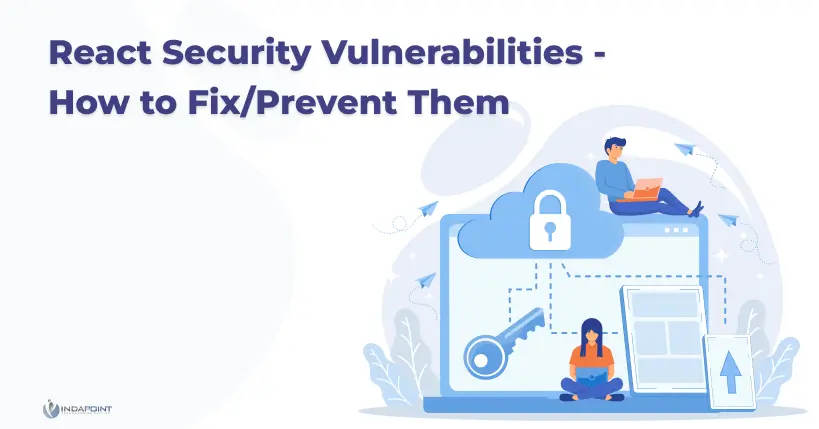React Security Vulnerabilities – How to Fix/Prevent Them
April 11, 2023

React is a popular front-end framework that uses to build efficient web applications. This includes single-page (SPAs) and multi-page pages (MPAs). React has many benefits but can be vulnerable to security issues if misused.
These potential threats must be understood and addressed by React security experts. This will help you protect your web application from potential threats and figure out how to fix React memory leaks. It can also reduce create-react—app vulnerabilities, improving its overall security.
React, despite its many advantages, can be vulnerable to security threats. As with all technology, being aware of and fixing potential security vulnerabilities is essential. We will discuss React apps’ security issues and the best React security practices to ensure their safety.
Why React js?
React js can quickly build interactive user interfaces or web applications using less code than vanilla JavaScript or any other framework. React allows you to create reusable components, which you can think of as Lego blocks. This makes it very flexible and practical. You can use it on many platforms once you’ve learned it. It’s a powerful tool for creating interactive interfaces. React.js allows web developers to create large web apps with high performance and easy scalability.
ReactJS Vulnerabilities and Best Practices
This can be considered a React Security Checklist. This list identifies the most prevalent vulnerabilities in ReactJS and how they can be prevented or fixed.
Cross-Site Scripting (“XSS”)
Cross-site scripting is when code is injected into your website by an attacker. Malicious code can alter elements of your website, steal cookies or delete data.
These types of issues are also difficult to detect by automated security scanners. XSS is one of the most severe threats to React apps. Strenuous escaping is one way to protect you against XSS vulnerabilities. It would help if you used this cautiously, as browsers are automatically programmed to escape HTML content. If misused, it can cause performance issues and could even ruin your React Native mobile app experience.
CSRF Attacks
Cross-Site Request Forgery is an attack where a logged-in user’s browser sends a forged HTTP request to their browser, without them knowing, to execute a malicious act. Since state-changing requests are more sensitive than “GET,” CSRF attacks target them specifically. An attacker can lure a victim to another site using social engineering, such as posting kitten-related messages or malware that can trigger attacks. There are other ways that attackers can access the cookies of your users without even being connected to your network.
CSRF Attacks
Cross-Site Request Forgery is an attack where a logged-in user’s browser sends a forged HTTP request to their browser, without them knowing, to execute a malicious act. Since state-changing requests are more sensitive than “GET,” CSRF attacks target them specifically. An attacker can lure a victim to another site using social engineering, such as posting kitten-related messages or malware that can trigger attacks. There are other ways that attackers can access the cookies of your users without even being connected to your network.
You can reduce the number of requests susceptible to CSRF attacks and protect yourself against malicious website links. This is why GET is preferred over other types, such as PUT and POST. These transform data while accessed through your browser, making them more vulnerable to forgery.
Dangerous URI schemes
A URI scheme is the default way to navigate with links. This is how your browser determines how to get from one page to another. JavaScript can be used in place of a regular URL. However, this opens your app to XSS attacks (cross-site scripting). This allows users to execute scripts in your browser with their data.
If you have an email input, for example, you could run JavaScript. alert (‘XSS Attack !’);’ in it. This would open an alert box with a message stating XSS Attack. You want something else. Avoid dangerous schemes like JavaScript: VBScript and other links-based navigation.
Sensitive Data Exposure
An unreliably implemented protection layer or weakly designed protection protocol can lead to sensitive data being exposed from your React web app. Unintended decryption may occur even if APIs are not compatible with your application.
Here are some ways you can protect your application from data exposure
Deactivate automated form caching or auto-filling features, which may collect data about users
Regularly ensure that the encryption algorithms are kept up-to-date
React SQL Injections
React is not the only web application that has SQL injection vulnerabilities. Attackers can use SQL vulnerabilities to bypass permissions, which could lead to database compromise. This is a grave concern, as a database breach that contains sensitive information or personal data can cause serious compliance problems and financial losses.
React applications can be susceptible to logic-based, error-based, or time-based injections. This is primarily due to needing to follow the principles of least privilege or a coding problem that has failed to filter user inputs.
Insufficient Authorization and Authentication

Authorization is the process of granting access to specific data. Authentication determines if that person is really who they claim to be. Common vulnerabilities are when authorization checks don’t cover all methods an app uses.
Users may need to log in before viewing their personal account details, but only after they can view customer orders. Hackers can use these privileged methods to access customer lists, personal account details, and other information by simply giving an access token (e.g., to a customer). These vulnerabilities can be mitigated by react apps using JWT and JSON Web Tokens to authorize.
XML External Entity Attacks (XXE)
An attacker can cause DoS by using XML data in web applications. This could result in system resource exhaustion or memory consumption. An attacker can use maliciously crafted XML data from outside your server to launch the attack.
Disable External Entities (libxml2) is required to protect you from XXE attacks. You can’t just change from one parser or library to another to protect yourself against XXE. If any patches have been released, you must upgrade libxml2 and libexpat. You can update your application using npm or yarn updates for each platform.
Malicious File Uploads

An attacker could upload malicious code to your server. They could send a form with an image field and get you to execute the malicious code on your server. It is possible to prevent this by verifying that all uploaded files are valid. Amazon S3 can prevent malicious file uploads. This service is easily accessible via their AWS IAM console.
Injection Attacks
An injection attack is when malicious code is injected into an application. Hackers can inject malicious code through websites and social media platforms. Hackers have been known to gain access to databases through injection attacks by hacking web pages. Hackers can gain access to databases and have control over sensitive data such as credit card numbers and financial information for many applications.
Keeping your data offline on a secure server/database is a good idea, especially if you have sensitive information such as credit card numbers or passwords. It is a good idea to use a dedicated server to store your data in order not to have any security breaches.
Conclusion
ReactJS security flaws are difficult to spot, so it is essential to pay attention to each component of React. You will need to hire subject-matter experts for such engagements. Without them, your chances of being exploited are higher. The ReactJS developer can address ReactJS security problems. They have the experience to address and fix many react security flaws before they negatively impact your brand. This will help stabilize and secure your ReactJS environment.





